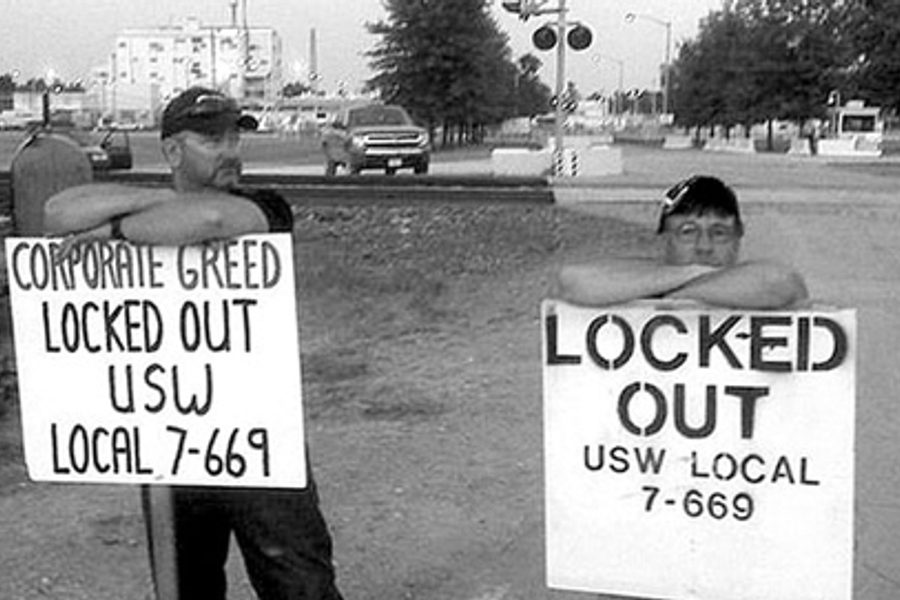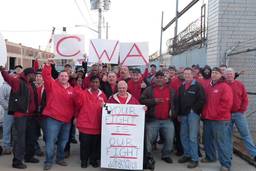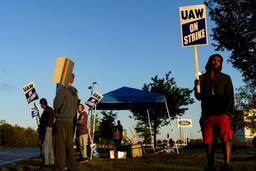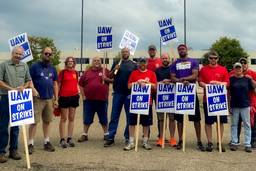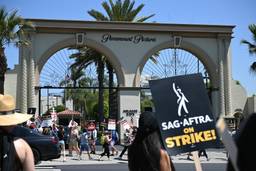After being locked out of their jobs for the last thirteen months, United Steelworkers (USW) Local 7-699, which represents 228 workers at Honeywell’s uranium enrichment facility in Metropolis, Illinois, agreed to a three-year contract that would return them to work. The contract was ratified by a vote of 113-75 last week.
The new agreement resists all the major issues that Honeywell sought to include such as increasing health care cost for current workers and eliminating health care for retirees. Workers will receive a one percent wage increase in the first year of the contract and a two percent increase in the second year.
However the contract does switch new hires to a different type of pension system, known as a shared equity pension, which will likely over the long run earn new hires significantly less than the defined pension currently enjoyed by union workers. Also, the new contract changes seniority for workers bidding for jobs in other departments, but does not change the way the seniority system functions during layoffs.
By far the most controversial part of the plan is the process of returning locked-out workers to the uranium facility. Since workers have been locked out of the plant for over six months, all the workers need to retrain on their certification to run the plant. Workers objected to Honeywell’s initial plan of re-entry because of the effect it would have on seniority, and forced Honeywell back to the table to re-work the plan.
A schedule is being phased in among each of three returning USW groups of hourly workers. The first group (the largest, with 150 USW members) will report on August 15 to the Paducah Community College campus for two weeks of certification training.
After a day-long debate and vote at the union hall on August 2, USW Local 7-669 President Darrell Lillie said the membership approved the agreement, including a separate back-to-work provision. He declared: “We fought one day longer on all the core issues and won them to our satisfaction. All of us who were locked out by Honeywell in June of last year who want to go back to work are doing so with union pride, a union contract and union solidarity.”
According to a USW press release, USW International President Leo W. Gerard, who worked with international unions to put pressure on Honeywell, has “flagged the dispute in meetings at the White House, with congressional leaders and federal regulatory agencies on Honeywell operating the uranium facility with inexperienced scabs.” Gerard struck an upbeat tone, saying:
“This is a victory earned in struggle by the Metropolis workers, their families and the community. Local 7-669 leaders and the members stood on the picket line as heroes who showed a commitment to fight an American multinational on principles that are rock solid about workplace safety, family health care, pensions, and job fairness.”
On a personal note, I have covered the Honeywell lockout for the last thirteen months. I have written more articles on the Honeywell lockout than I have on any other labor struggles. As an investigative reporter, I covered everything from how Honeywell was able to cheat on its safety tests for scabs, to the multiple accidents caused by those scabs, and how President Barack Obama and Senate Democrats continued to invite Honeywell CEO David Cote on trips and special events during the lockout. While Cote appeared on Meet the Press and ABC This Morning without being asked questions about the safety risk the uranium facility’s lockout was imposing on the surrounding community, I tried to ask the questions of Honeywell’s CEO that establishment journalists Christiane Amanpour and David Gregory failed to ask.
Over those thirteen months, I got to know some of the men personally over late night phone calls and visits. I ate dinners at their homes with their families, went to their sons’ little league games, drank beers with them, and once a group of union workers even saved me from getting beat up at a bar when I inadvertently upset a scab by trying to interview him for an article. During the course of my coverage of the Honeywell lockout, they became not only my friends, but my heroes.
They were ordinary people leading ordinary lives raising families in a picturesque small American town until their lives where shaken when they were locked out of their jobs and forced to fight one of the most powerful defense contractors in the United States. They did not subscribe to liberal publications or attend weekly meetings of liberal groups; they were regular people who were forced to become activists. As union member Rick McConnell told me: “I didn’t become a union activist, Honeywell made me an activist.”
They traveled to Europe to gain the support of European trade unionists, they worked with immigrant groups In Los Angeles to deny a water contract to Honeywell, and they stood on stage as 125,000 people protested in Madison, Wisconsin.
But their toughest fight was to keep themselves motivated and united. What struck me in my last visit to Metropolis on the one year anniversary of the lockout was not the challenge of taking on a corporation as tough as Honeywell, but the difficulty of getting people to stand up and fight for themselves. Many workers just simply wanted to get back to work and didn’t see how they could possibly win against a mega-corporation like Honeywell. So the local organized activities to keep workers involved and upbeat. “I just can’t wait till I get my job so I can finally have some free time, being locked out I work around the clock,” Stephen Lech joked with me.
They were able to keep their union together and won improvements on contracts when the goal of Honeywell was, quite simply, to bust their union. In the strength they showed during the lockout, these workers inspired not only me, but people all over the nation and the world.
For now the lockout at Honeywell is over. But I doubt this will be the last I will hear from the troublemakers in Metropolis, Illinois.

I hope you found this article important. Before you leave, I want to ask you to consider supporting our work with a donation. In These Times needs readers like you to help sustain our mission. We don’t depend on—or want—corporate advertising or deep-pocketed billionaires to fund our journalism. We’re supported by you, the reader, so we can focus on covering the issues that matter most to the progressive movement without fear or compromise.
Our work isn’t hidden behind a paywall because of people like you who support our journalism. We want to keep it that way. If you value the work we do and the movements we cover, please consider donating to In These Times.
